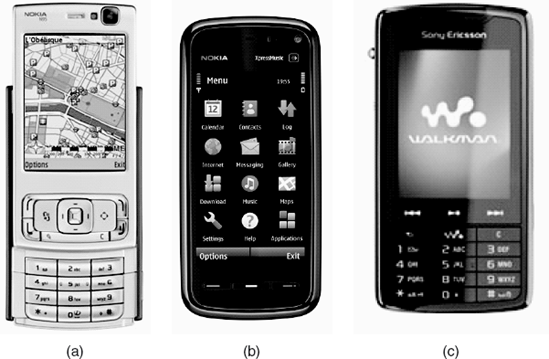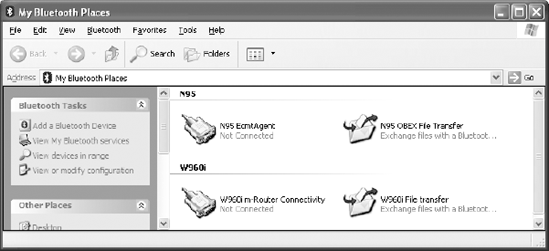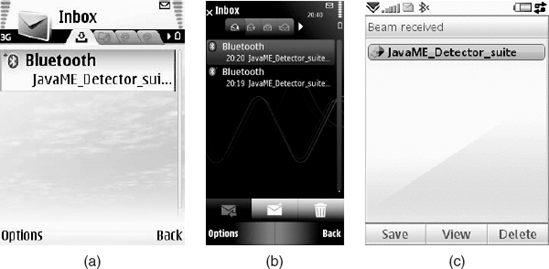Being able to deploy and run an application on a target Symbian smart-phone is a prerequisite for any discussion or development.
A Symbian smartphone can be
built on different versions of Symbian OS, can come from different phone
manufacturers, can have different form factors and different UI
designs. For that reason, we choose three devices that represent the
different flavors of Symbian smartphones that are currently in the
market (see Figure 1).
The Nokia N95 is an S60 3rd Edition device that can be operated with
one hand; the Nokia 5800 XpressMusic is an S60 5th Edition device with a
resistive touch screen and tactile feedback; the Sony Ericsson W960i is
a UIQ 3 device with a touch screen.

Tradition says that the first application should be
the canonical'Hello World' program. Since we assume that you are already
familiar with MIDP development, we're going to use a new introductory
application that allows us both to run our first application and to
answer a question that developers ask every time they get a new device:
what JSRs are supported on the device?
The first application that we run on a Symbian
smartphone is a utility to detect which APIs are supported.
1. Implementing the Java ME Detectors Suite
To develop the application we need an SDK and an IDE.
NetBeans and Java ME SDK 3.0 are sufficient for creating your first
MIDlet. That tells you that Java ME development for Symbian OS can be
done using the standard Java ME tools and SDKs that you have always
used.
Create a project named 'Java ME Detectors' in NetBeans. It will contain three classes: JSRsDetectorMIDlet, JSRsView and ApiInfo (source code and binaries can be downloaded from the website for this book, developer.symbian.com/javameonsymbianos).
The main functionality of the application is to receive as input the
name of a JSR and a main class from that JSR, and to detect if it is
supported. The input can come from the JAD, JAR manifest file,
properties file, or the UI.
The Mobile Services Architecture (MSA) defines system
properties for each JSR that indicate whether the JSR is supported or
not. For example, wireless.messaging.version returns the WMA
version supported by the device. However, to make this utility portable
for devices which are not compliant with MSA, we detect the JSR by
trying to load a sample class.
ApiInfo encapsulates the information that is
read as input: the name of the API and its main class, which indicates
that the JSR is supported if it can be dynamically loaded:
// Encapsulates an API's name and main class
public class ApiInfo {
String name;
String mainClass;
}
JSRsView contains the core application task,
which is to detect the list of APIs given as input. When the user
presses Detect, an array of ApiInfo is requested from the MIDlet and, for each ApiInfo in the array, the JSRsView.detectAPIs() method tries to load a Java class whose name is stored in the ApiInfo.mainClass member:
// The user view of the JSRs Detector MIDlet
public class JSRsView extends Form implements CommandListener {
private Command exit = new Command("Exit", Command.EXIT, 0);
private Command detect = new Command("Detect", Command.OK, 0);
private JSRsDetectorMIDlet midlet;
// CommandListener implementation
public void commandAction(Command cmd, Displayable disp) {
if (cmd == exit) {
midlet.notifyDestroyed();
} else if (cmd == detect) {
detectAPIs();
}
}
// Detect supported APIs
private void detectAPIs() {
resetUl();
ApiInfo[] detectedApis = midlet.getApiInfoArray();
for (int i = 0; i < detectedApis.length; i++) {
try {
Class.forName(detectedApis[i].mainClass);
// class loaded successfully – API is supported
append(detectedApis[i].name + ": Yes\n");
} catch (ClassNotFoundException cnfe) {
// class not loaded– API is NOT supported
append(detectedApis[i].name + ": No\n");
}
}
}
}
The default input to JSRsDetectorMIDlet can be read from the JAD file by calling the MIDlet's getAppProperty() method sequentially until NULL is returned. The following JAD properties are loaded and parsed by the MIDlet to create the array of ApiInfo objects:
JSR1: JSR-139 CLDC 1.1, java.lang.Float
JSR2: JSR-118 MIDP 2.0, javax.microedition.lcdui.Custom-Item
JSR3: JSR-75 PIM, javax.microedition.pim.PIM
JSR4: JSR-75 FileConnection, javax.microedition.io.file.FileConnection
JSR5: JSR-82 Bluetooth, javax.bluetooth.LocalDevice
JSR6: JSR-135 MMAPI, javax.microedition.media.Manager
JSR7: JSR-172 WS, javax.xml.rpc.JAXRPCException
JSR8: JSR-120 WMA 1.0, javax.wireless.messaging.Mess-ageConnection
JSR9: JSR-177 SATSA-APDU, javax.microedition.apdu.APDUConnection
JSR10: JSR-177 SATSA-JCRMI, javax.microedition.jcrmi.JavaCardRMIConnection
JSR11: JSR-177 SATSA-PKI, javax.microedition.security-service.CMSMessageSignatureService
JSR12: JSR-177 SATSA-CRYPTO, javax.crypto.Cipher
JSR13: JSR-179 Location, javax.microedition.location.Location
JSR14: JSR-180 SIP, javax.microedition.sip.SipConnection
JSR15: JSR-184 3D, javax.microedition.m3g.Graphics3D
JSR16: JSR-205 WMA 2.0, javax.wireless.messaging.Size-ExceededException
JSR17: JSR-211 CHAPI, javax.microedition.content.ContentHandler
JSR18: JSR-226 SVG, javax.microedition.m2g.SVGImage
JSR19: JSR-229 Payment, javax.microedition.payment.TransactionModule
JSR20: JSR-234 AMMS, javax.microedition.amms.Global-Manager
JSR21: JSR-238 i18n, javax.microedition.global.ResourceManager
After downloading Java ME Detectors from the Sun Developer Network, you can build and deploy it to a device.
2. Deployment over a Short Link
Symbian OS, as an open platform, serves developer
needs well and serves as an excellent open Java ME development platform
even if you are developing a mobile applications for platforms other
than Symbian OS.
You may deploy your suite over the air by putting it
on a web server. In reality, most developers prefer a quicker and
simpler mechanism so beaming the suite JAR over a short-link connection
is simpler and faster. For our first deployment, we do not use a
device-manufacturer tool or SDK but only the reference devices and a
laptop with Blue-tooth.
After pairing the devices (Nokia N95 and Sony
Ericsson W960i) with the laptop, you can send the JAR file for
installation. From Windows File Explorer, go to the location of the
suite binaries and drag the JAR to the appropriate file transfer service
in My Bluetooth Places (see Figure 2).
Alternatively, from Windows File Explorer, go to the location of the
suite binaries, right click on the JAR file, and select Send to,
Bluetooth. A submenu shows the paired devices and you can choose the
correct device.

When you send the JAR to the Nokia N95, it is stored in the Messaging Inbox (Figure 3a). When you send the JAR to the Sony Ericsson W960i, you are immediately presented with it (Figure 3b).

As you can see, how the device handles the suite is
specific to that device. For example, the MIDlet may go into the
Messaging Inbox or the Application Management System (AMS) may be
automatically or manually activated. In any case, the process itself is
very simple and straightforward.
To complete the installation:
on the Nokia N95, click all the way through until you are notified that the installation has completed
on the Sony Ericsson W960i, press View and click all the way through until AMS launches the application.
3. Launching Java ME Detectors
On the majority of Java-enabled feature phones, you
launch a Java application from a designated menu on which all installed
Java applications reside. An important feature of Symbian OS is that
Java applications are executed from the main applications menu, just
like native applications. In this respect, Java applications are treated
as 'first-class citizens' and are no different to any native
application installed or running on the device.
Now that the Java installer has completed its task, let's run JSRsDetectorMIDlet on our reference devices:
On the Nokia N95, click on Main menu, Applications.
On the Sony Ericsson W960i, from the home screen, press Menu, Tools.
Both devices present you with the main application menu from which all installed applications are launched (see Figure 4). Select the MIDlet and run it. Congratulations, you have just completed the task of running a MIDlet on a Symbian smartphone.

Table 1 shows the results of running JSRsDetectorMIDlet.
As you can see, all the reference devices support more JSRs than there
are in the MSA subset. In fact, they are very close to supporting all
MSA Component JSRs.
Table 1. Supported JSRs in Reference Phones
| JSR | Nokia N95 | Nokia 5800 XpressMusic | Sony Ericsson W960i |
|---|
| JSR-139 CLDC 1.1 | ✓ | ✓ | ✓ |
| JSR-118 MIDP 2.0/2.1 | 2.0 | 2.1 | 2.0 |
| JSR-75 PDA Packages | ✓ | ✓ | ✓ |
| JSR-82 Bluetooth and OBEX | ✓ | ✓ | ✓ |
| JSR-120 WMA 1.1 | ✓ | ✓ | ✓ |
| JSR-135 Mobile Media API 1.1 | ✓ | ✓ | ✓ |
| JSR-172 Web Services 1.0 | ✓ | ✓ | ✓ |
| JSR-177 SATSA JCRMI, APDU, PKI, CRYPTO | – – ✓✓ | – – ✓✓ | – |
| JSR-179 Location | ✓ | ✓ | – |
| JSR-180 SIP | ✓ | – | – |
| JSR-184 Mobile 3D Graphics | ✓ | ✓ | ✓ |
| JSR-205 WMA 2.0 | ✓ | ✓ | ✓ |
| JSR-211 CHAPI | – | – | – |
| JSR-226 SVG | ✓ | ✓ | ✓ |
| JSR-229 Payment | – | – | ✓ |
| JSR-234 AMMS | ✓ | ✓ | – |
| JSR-238 i18n | – | – | – |
4. Summary
This is probably not the first time you have deployed
a MIDlet suite onto a real device but you can clearly see how fast and
easy it is to do on a Symbian smartphone. Java ME development and
deployment is easy because Symbian OS is an open platform which serves
developers needs well. Later, we learn about additional ways to deploy,
launch and manage Java ME applications, which will help you throughout
your development.
We intentionally replaced the standard 'Hello World'
program with the Java ME Detectors suite, which gives you a diagnosis
tool to put into your personal development toolbox. You can always check
on the web
to see the Java specification of a device but the Java ME Detectors
suite gives you an extensible tool that refers specifically to the
device you are holding in your hands.